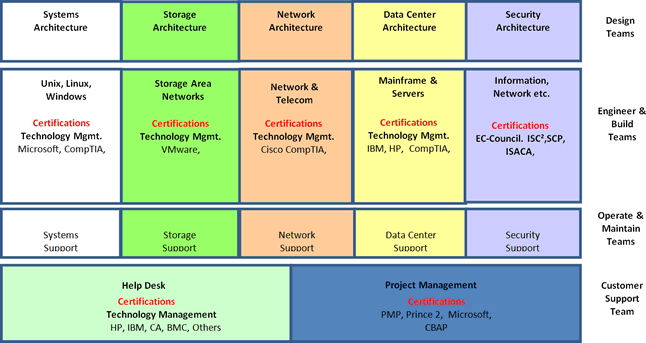The current IT Service Provider paradigm is very similar to that of manufacturing organizations from the last century. That is, most of the work was done by specialists, operations were independent of each other, integration was an afterthought and manual intervention was the preferred method for problem solving. The inefficiencies of this model largely constrained supply chains and in some cases brought them to a grinding halt.
Compare that with manufacturing of today. One can come up with an idea for a new product, have the prototype developed within a few weeks and then go into full production a few months later. This capability is directly related to the implementation of best practices (ISO 9002 etc.) that enabled manufacturers to operate using a common set of controls for the design, delivery and support of new products. Apple Computer and Cisco Systems are a good example of this.
There are two trends developing in IT that have the potential to improve IT's response time for service delivery while reducing its operations cost; IT Service Management (ITSM) and IT Cloud Management (ITCM).
IT Service Management
IT Service Management is a set of specialized organizational capabilities for providing value to customers in the form of services. IT Service Management seeks to implement and manage the quality of IT Services in terms of people, process and technology.
ITSM planning & design processes enable IT to achieve an unambiguous understanding of its customer's needs and a repeatable way to define and categorize the enterprise technology, capability and process requirements. Underpinning all of this is IT's ability to use established sourcing policies and guidelines to determine if a service should be delivered internally or externally. This is all done in the context of governance based on enterprise goals and achievement measured against expected outcomes.
ITSM delivery processes ensure consistency of execution. This is critical because day-to-day business processes rely so much on embedded technology that failure to execute consistently directly impacts the enterprise's ability to deliver its product or service.
IT Cloud Computing & Management
The second in cloud computing. According to Wikipedia, cloud computing is the delivery of computing as a service rather than a product, whereby shared resources, software, and information are provided to computers and other devices as a utility (like the electricity grid) over a network (typically the Internet). The impact that cloud computing is having on business is so great that the United States federal government is looking to the cloud as a means to decrease its total cost of ownership (workloads).
IT provides the portal through which the enterprise receives its enabling business technology. IT brokers those services irrespective of their source, internal or external. Therefore, IT must provide a utility grade delivery platform that enables the enterprise to manage technology investments and innovation in a structured manner.
ITSM/ITCM Synergy
When combined, these trends enable IT organizations to demonstrate the main characteristics of an external service provider; a clear and unambiguous understanding of their customer's need, repeatable processes to ensure quality and consistency of execution, and the ability to innovate in a structured manner.
IT Organizations - Today
The diagram below shows what most IT organizations look like today – technology driven, silo-ed with minimal focus on the client experience.

IT Organization - 2012 & Beyond
The diagram shows what IT organizations will evolve to once ITSM and ITCM are added to the mix – four IT practice areas with a focus on resource optimization and client experience.

IT Service Management
IT Service Management (ITSM) is an IT practice area that is concerned with the design and delivery of high quality, value add IT services that meet or exceeds the needs of the business client they service. ITSM involves a transition from delivering services as stacks of individual components to that of solutions that enable successful business outcomes. ITSM roles include, ITSM Expert, Practitioners, Auditors and IT Business Analysts. Certifications include: ITIL®, ISO/IEC20000, CobiT® and CBAP®.
IT Cloud Management
IT Cloud Management (ITCM) is a new IT practice area that is concerned with the design and delivery of flexible, high quality computing, infrastructure and application services that meets or exceeds the service needs of their ITSM client. ITCM roles include, Architect, Administrator and Planner. Certifications include: CompTIA, Vendor and third party vendor neutral certifications.
IT Network Management
IT Network Management (ITNM) is an IT practice area that is concerned with the design and delivery of high quality, value add technology solutions that meets or exceeds the service needs of their ITSM client. Service areas include a wide area of topics including security, performance, reliability and support. Roles will include IT design, technology and security management specialists. Certifications include: Cisco®, Microsoft®, CompTIA®, VMware®, EC Council, ISC2®, ISACA® and SCP.
IT Project Management
IT Project Management (ITPM) is an IT practice area that is concerned with the body of knowledge (BOK) the outlines the principles, techniques, and tools used in managing the successful outcome of IT projects. ITPM's main job is to make sure ITSM meets or exceeds its goals for delivering high quality services to its business clients. Roles include Project Management Professional and. Certifications include: PMP® and Prince2®.
Summary
Charles Darwin astounded the world when he theorized, in his book "The Origins of Species," that species evolved over time in response to their environment through the process of natural selection. Only those organisms that successfully adapt to the environment survive and pass their genes onto the next generation. One could argue the point that natural selection is at work in the information technology world. If IT is going to survive and "pass on its genes," it needs to adapt to this new ecological niche before the one it currently occupies closes up.